《微生物学 Microbiology》课程PPT教学课件(英文版)antimicrobial drugs 1/2
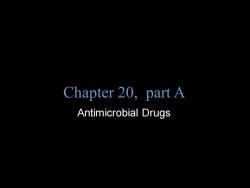
Chapter 20,part A Antimicrobial Drugs
Copyright © 2004 Pearson Education, Inc., publishing as Benjamin Cummings B.E Pruitt & Jane J. Stein Chapter 20, part A Antimicrobial Drugs

Antimicrobial Drugs 。Chemotherapy The use of drugs to treat a disease 。Antimicrobial drugs Interfere with the growth of microbes within a host 。Antibiotic Substance produced by a microbe that,in small amounts, inhibits another microbe 。Selective toxicity A drug that kills harmful microbes without damaging the host
Antimicrobial Drugs • Chemotherapy The use of drugs to treat a disease • Antimicrobial drugs Interfere with the growth of microbes within a host • Antibiotic Substance produced by a microbe that, in small amounts, inhibits another microbe • Selective toxicity A drug that kills harmful microbes without damaging the host
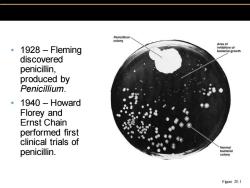
Penicillium colony Area of 。1928-Fleming inhibition of bacterial growth discovered penicillin, produced by Penicillium. 1940 Howard Florey and Ernst Chain performed first clinical trials of Normal penicillin. bacterial colony Figure 20.1
• 1928 – Fleming discovered penicillin, produced by Penicillium . • 1940 – Howard Florey and Ernst Chain performed first clinical trials of penicillin. Figure 20.1
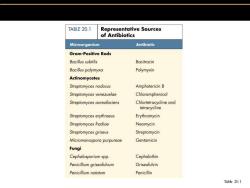
TABLE 20.1 Representative Sources of Antibiotics Microorganism Antibiotic Gram-Positive Rods Bacillus subtilis Bacitracin Bacillus polymyxa Polymyxin Actinomycetes Streptomyces nodosus Amphotericin B Streptomyces venezuelae Chloramphenicol Streptomyces aureofaciens Chlortetracycline and tetracycline Streptomyces erythraeus Erythromycin Streptomyces fradiae Neomycin Streptomyces griseus Streptomycin Micromonospora purpureae Gentamicin Fungi Cephalosporium spp. Cephalothin Penicillium griseofulvum Griseofulvin Penicillium notatum Penicillin Table 20.1
Table 20.1
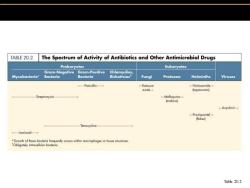
TABLE 20.2 The Spectrum of Activity of Antibiotics and Other Antimicrobial Drugs Prokaryotes Eukaryotes Gram-Negative Gram-Positive Chlamydias Mycobacteria" Bacteria Bacteria Rickettsias Fungi Protozoa Helminths Viruses —Penicil诽in一 -Ketocon -Niclosamide azole (tapeworms] Streptomycin- -Mefloquine一 (malaria) -Acyclovir- -Praziquontel-一 (flukes] Tetracycline -lsoniozid *Growth of these bacteria frequently occurs within macrophages or tissue structures. Obligately inraceuabacterio. Table 20.2
Table 20.2
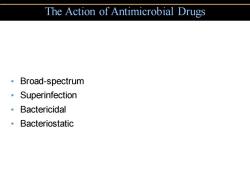
The Action of Antimicrobial Drugs 。Broad-spectrum 。Superinfection 。Bactericidal Bacteriostatic
The Action of Antimicrobial Drugs • Broad-spectrum • Superinfection • Bactericidal • Bacteriostatic
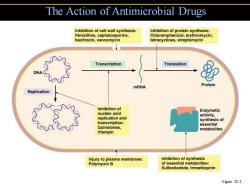
The Action of Antimicrobial Drugs Inhibition of cell wall synthesis: Inhibition of protein synthesis: Penicillins,cephalosporins, Chloramphenicol,erythromycin, bacitracin,vancomycin tetracyclines,streptomycin Transcription Translation mRNA Protein Replication Inhibition of Enzymatic nucleic acid activity, replication and synthesis of transcription: essential Quinolones, metabolites rifampin Injury to plasma membrane: Inhibition of synthesis Polymyxin B of essential metabolites: Sulfanilamide,trimethoprim Figure 20.2
The Action of Antimicrobial Drugs Figure 20.2
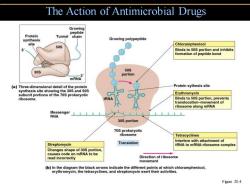
The Action of Antimicrobial Drugs Growing peptide Protein Tunnel chain synthesis Growing polypeptide site Chloramphenicol 50S Binds to 50S portion and inhibits formation of peptide bond 30S 50S portion mRNA (a)Three-dimensional detail of the protein Protein sythesis site synthesis site showing the 30S and 50S subunit portions of the 70S prokaryotic Erythromycin ribosome. RNA Binds to 50S portion,prevents translocation-movement of ribosome along mRNA Messenger RNA 30S portion 70S prokaryotic ribosome Tetracyclines Interfere with attachment of Streptomycin Translation tRNA to mRNA-ribosome complex Changes shape of 30S portion. causes code on mRNA to be read incorrectly Direction of ribosome movement (b)In the diagram the black arrows indicate the different points at which chloramphenicol, erythromycin,the tetracyclines,and streptomycin exert their activities. Figure 20.4
The Action of Antimicrobial Drugs Figure 20.4
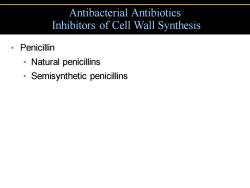
Antibacterial Antibiotics Inhibitors of Cell Wall Synthesis 。Penicillin ·Natural penicillins Semisynthetic penicillins
• Penicillin • Natural penicillins • Semisynthetic penicillins Antibacterial Antibiotics Inhibitors of Cell Wall Synthesis

Penicillins Common nucleus S、/CH Penicillin G(Requires injection) CH2-C-NH-CH-CH C CH2 O=C—N—CH-COOH 0 S、/CH Penicillin V(Can be taken orally) OCH2-C-NH-CH-CH O-CN CH COOM B-lactam ring (a)Natural(antibiotic)penicillins Common nucleus 0 S、CH Oxacillin C-NH-CH-CH (Resistant to penicillinase) CH3 0=C十N—GHC地ooH B-lactam ring S、CH Ampicillin(Extended spectrum) CH-C-NH-CH-CH CH3 NH2 O=C—N—CH-COOH (b)Semisynthetic penicillins Figure 20.6
Penicillins Figure 20.6
按次数下载不扣除下载券;
注册用户24小时内重复下载只扣除一次;
顺序:VIP每日次数-->可用次数-->下载券;
- 云南农业大学:《微生物学》课程教学资源(PPT课件)第四章 微生物的生长和环境条件.ppt
- 云南农业大学:《微生物学》课程教学资源(PPT课件)第六章 真核微生物.ppt
- 云南农业大学:《微生物学》课程教学资源(PPT课件)第八章 微生物的生态.ppt
- 云南农业大学:《微生物学》课程教学资源(PPT课件)第五章 原核生物.ppt
- 云南农业大学:《微生物学》课程教学资源(PPT课件)第三章 细菌的遗传和变异.ppt
- 云南农业大学:《微生物学》课程教学资源(PPT课件)第七章 病毒.ppt
- 云南农业大学:《微生物学》课程教学资源(PPT课件)绪论(主讲:刘雅婷).ppt
- 云南农业大学:《微生物学》课程教学资源(PPT课件)第二章 微生物的营养和代谢.ppt
- 云南农业大学:《微生物学》课程教学资源(PPT课件)第一章 微生物的细胞.ppt
- 《微生物学》课程教学资源(PPT课件)第八章 微生物生态.ppt
- 《微生物学》课程教学资源(PPT课件)第九章 传染与免疫.ppt
- 《微生物学》课程教学资源(PPT课件)第七章 微生物的遗传变异和育种.ppt
- 《微生物学》课程教学资源(PPT课件)第四、五章 微生物的营养与培养基.ppt
- 《微生物学》课程教学资源(PPT课件)第六章 微生物的生长繁殖及其控制.ppt
- 《微生物学》课程教学资源(PPT课件)第二章 真核微生物.ppt
- 《微生物学》课程教学资源(PPT课件)第三章 病毒和类病毒(亚病毒).ppt
- 《微生物学》课程教学资源(PPT课件)第一章 原核生物.ppt
- 《植物生殖生物学》课程教学资源(课件讲稿)植物雄性不育性 Plant male sterility.pdf
- 《植物生殖生物学》课程教学资源(课件讲稿)Biology of pollen development(PPT).ppt
- 《植物生殖生物学》课程教学课件(PPT讲稿)Chapter 5 胚胎的 发育 Embryogenesis(PPT).ppt
- 《微生物学 Microbiology》课程PPT教学课件(英文版)antimicrobial drugs 2/2.ppt
- 《微生物学 Microbiology》课程PPT教学课件(英文版)applied and industrial microbiology.ppt
- 《微生物学 Microbiology》课程PPT教学课件(英文版)biotechnology and recombinant DNA 1/2.ppt
- 《微生物学 Microbiology》课程PPT教学课件(英文版)biotechnology and recombinant DNA 2/2.ppt
- 《微生物学 Microbiology》课程PPT教学课件(英文版)chemical principles 1/2.ppt
- 《微生物学 Microbiology》课程PPT教学课件(英文版)chemical principles 2/2.ppt
- 《微生物学 Microbiology》课程PPT教学课件(英文版)classification of microrganisms 1/2.ppt
- 《微生物学 Microbiology》课程PPT教学课件(英文版)classification of microrganisms 2/2.ppt
- 《微生物学 Microbiology》课程PPT教学课件(英文版)disorders associated with the immune system 1/2.ppt
- 《微生物学 Microbiology》课程PPT教学课件(英文版)disorders associated with the immune system 2/2.ppt
- 《微生物学 Microbiology》课程PPT教学课件(英文版)domains bacteria archaea 1/5.ppt
- 《微生物学 Microbiology》课程PPT教学课件(英文版)domains bacteria archaea 2/5.ppt
- 《微生物学 Microbiology》课程PPT教学课件(英文版)domains bacteria archaea 3/5.ppt
- 《微生物学 Microbiology》课程PPT教学课件(英文版)domains bacteria archaea 4/5.ppt
- 《微生物学 Microbiology》课程PPT教学课件(英文版)domains bacteria archaea 5/5.ppt
- 《微生物学 Microbiology》课程PPT教学课件(英文版)environmental microbiology 1/3.ppt
- 《微生物学 Microbiology》课程PPT教学课件(英文版)environmental microbiology 2/3.ppt
- 《微生物学 Microbiology》课程PPT教学课件(英文版)environmental microbiology 3/3.ppt
- 《微生物学 Microbiology》课程PPT教学课件(英文版)functional anatomy of prokaryotic and eukaryotic cells 1/2.ppt
- 《微生物学 Microbiology》课程PPT教学课件(英文版)functional anatomy of prokaryotic and eukaryotic cells 2/2.ppt
